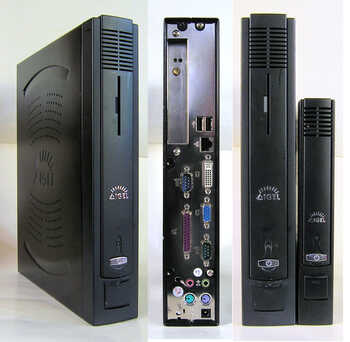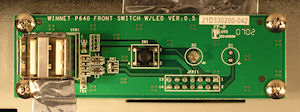
The label on the side of this unit identifies it as an Igel 5/4. Igel's website doesn't list this particular model number. However, when booted, the 'IGEL setup' application identifies it as a 4210LX Winestra. This model reached end-of-life on 31/01/2009 and firmware support is scheduled to end 01/02/2012.
As you can see from the comparison photograph above it is considerably larger than the 2110 style model. Internally the circuit board carries the designation WinNET P680. Google tells me this is the same board that is used in the HP/Neoware e140 thin client (aka CA22).
There is nothing immediately obvious on the hardware that indicates the date of manufacture. However, if you remove the front panel, on the rear of the panel you can find the date that it was injection moulded. In my case the date was 4th January 2007, so the 4210LX was probably manufactured in early 2007.
[January 2018]. In this revisit to the 4210 I find that I have two examples of the 4210 - I must have acquired another one along the way. Visually they are the same - the earlier one being in black, the later one in light grey/dark grey. The front panel injection moulding of the later one carries a date of August 2008. They both carry the same Igel 5/4 label on the cover. However on further examination the PCB on the earlier one is screen printed WinNET P680 V1.0 and carries a white paper label V1-02. The later one is screen printed WinNET P680 V1.2 and carries a white paper label V3-06.
The basic specs are:
Processor Type
SpeedVia C7
1.0 GHzMemory Flash
RAM128MB
256MB (max 1GB)Video Chip
Max resolutionVia CN700
1920 x 1440 16-bit colourPorts Video
Network
USB
Serial
Parallel
PS/2DVI & VGA
10/100
2 x USB2.0 front
2 x USB2.0 rear
2
1
Kybd & MousePower Plug
Off
RunningCoax 5.5mm/2.1mm
2W
~23WDimensions W x H x D 5.0cm x 29.3cm x 23.3cm
The 4210LX runs IGEL's version of Linux.
For those to whom it matters here is some detail from Linux's /proc/cpuinfo.
There has been a change in CPU in the two models I have, the earlier one being fitted with a VIA Esther CPU while the later one has a VIA C7.
Early model.
vendor_id : CentaurHauls cpu family : 6 model : 10 model name : VIA Esther processor 1000MHz stepping : 9 flags : fpu vme de pse tsc msr pae mce cx8 sep mtrr pge cmov pat clflush acpi mmx fxsr sse sse2 tm nx eagerfpu pni est tm2 rng rng_en ace ace_en ace2 ace2_en phe phe_en pmm pmm_en
Later model.
vendor_id : CentaurHauls cpu family : 6 model : 13 model name : VIA C7 Processor 1000MHz stepping : 0 flags : fpu vme de pse tsc msr pae mce cx8 sep mtrr pge cmov pat clflush acpi mmx fxsr sse sse2 tm nx eagerfpu pni est tm2 xtpr rng rng_en ace ace_en ace2 ace2_en phe phe_en pmm pmm_en
In note the later processor has gained an extra flag - xtpr.
00:00.0 Host bridge: VIA Technologies, Inc. CN700/VN800/P4M800CE/Pro Host Bridge 00:00.1 Host bridge: VIA Technologies, Inc. CN700/VN800/P4M800CE/Pro Host Bridge 00:00.2 Host bridge: VIA Technologies, Inc. CN700/VN800/P4M800CE/Pro Host Bridge 00:00.3 Host bridge: VIA Technologies, Inc. PT890 Host Bridge 00:00.4 Host bridge: VIA Technologies, Inc. CN700/VN800/P4M800CE/Pro Host Bridge 00:00.7 Host bridge: VIA Technologies, Inc. CN700/VN800/P4M800CE/Pro Host Bridge 00:01.0 PCI bridge: VIA Technologies, Inc. VT8237/VX700 PCI Bridge 00:0f.0 IDE interface: VIA Technologies, Inc. VT82C586A/B/VT82C686/A/B/VT823x/A/C PIPC Bus Master IDE (rev 06) 00:10.0 USB controller: VIA Technologies, Inc. VT82xx/62xx UHCI USB 1.1 Controller (rev 81) 00:10.1 USB controller: VIA Technologies, Inc. VT82xx/62xx UHCI USB 1.1 Controller (rev 81) 00:10.2 USB controller: VIA Technologies, Inc. VT82xx/62xx UHCI USB 1.1 Controller (rev 81) 00:10.3 USB controller: VIA Technologies, Inc. VT82xx/62xx UHCI USB 1.1 Controller (rev 81) 00:10.4 USB controller: VIA Technologies, Inc. USB 2.0 (rev 86) 00:11.0 ISA bridge: VIA Technologies, Inc. VT8237 ISA bridge [KT600/K8T800/K8T890 South] 00:11.5 Multimedia audio controller: VIA Technologies, Inc. VT8233/A/8235/8237 AC97 Audio Controller (rev 60) 00:12.0 Ethernet controller: VIA Technologies, Inc. VT6102/VT6103 [Rhine-II] (rev 78) 01:00.0 VGA compatible controller: VIA Technologies, Inc. CN700/P4M800 Pro/P4M800 CE/VN800 Graphics [S3 UniChrome Pro] (rev 01)
There is no difference in the listings between the examples other than the earlier one also includes the fitted wireless card.
00:08.0 Network controller: Ralink corp. RT2561/RT61 802.11g PCI
The IGEL 4210LX uses an external 12V supply with a conventional 5.5mm/2.1mm coaxial type connector. Although the label on the case says "12V 4A/50W max" I find that the 4210LX actually runs at a power consumption of 23W-28W depending on what it is actually doing.
Both the Flash memory and the RAM in the 4210LX are easily replaceable.
Flash: The flash memory is a Compact Flash card plugged into a socket adjacent to a 44-pin IDE connector.
RAM: There is a single 200-pin DDR2 SODIMM socket for the RAM. The 256MB DIMM supplied with the unit is labelled: 256MB DDR2 533 168245-1998 and is manufactured by Transcend. I've replaced it by some unlabelled 512MB modules with out any problems. However, when I tried a 1GB module from Crucial (128Mx64), it was only reported as being 512MB. A possible explanation for this can be found here.
[January 2018]: A 1GB low density part (Samsung M470T2953EZ3-CE6 - 8 chips per side) worked perfectly. A 1GB high density part (Hynix HYMP112S64CP6-Y5 - 4 chips per side) didn't work.
There is a riser card with a PCI socket so that a PCI card can be fitted internally. As can be seen in the photograph the unit I purchased came with a Wireless Network card fitted. I don't know if this is standard or an after-market fit.
In the middle of the board just adjacent to the connection to the serial port is another header marked USB1. This provides two more USB ports. You could connect these to something mounted internally, or, if you're not using the PCI slot, to two standard USB sockets mounted on a back-panel plate. (See the Neoware CA15 for a photograph of what I mean). You can find these on ebay from far east suppliers for under £2.
 The plastic front panel is held on by six plastic lugs pushed through slots in the metal
front panel. There are two at the bottom, two in the middle
and two at the top. It is possible with a little bit of care to remove this. This exposes the
front panel circuit board which you can see has provision for fitting another LED.
The plastic front panel is held on by six plastic lugs pushed through slots in the metal
front panel. There are two at the bottom, two in the middle
and two at the top. It is possible with a little bit of care to remove this. This exposes the
front panel circuit board which you can see has provision for fitting another LED.
Rainer wrote: You can solder an Ethernet-link LED at the front panel (above the power led). There is no hole in the front, but drilling the igel logo from the back (just a bit to make the plastic thinner) and mounting the led behind it worked well - now the igel flashes at network activity.
I found that you could also remove the front panel insert which might help in doing this mod should you wish to mount the LED in it's original position (or elsewhere).

 The photos show the front panel with the insert removed and the rear of the insert. The two red
arrows show the two mounting lugs and corresponding mounting holes. Once these are released the
insert can be slid up and removed.
The photos show the front panel with the insert removed and the rear of the insert. The two red
arrows show the two mounting lugs and corresponding mounting holes. Once these are released the
insert can be slid up and removed.
My thanks to Rainer Wetzel who pointed out the USB header and also was the one who disassembled the front panel to find the missing LED and spotted the manufacturing date moulded into the plastic.